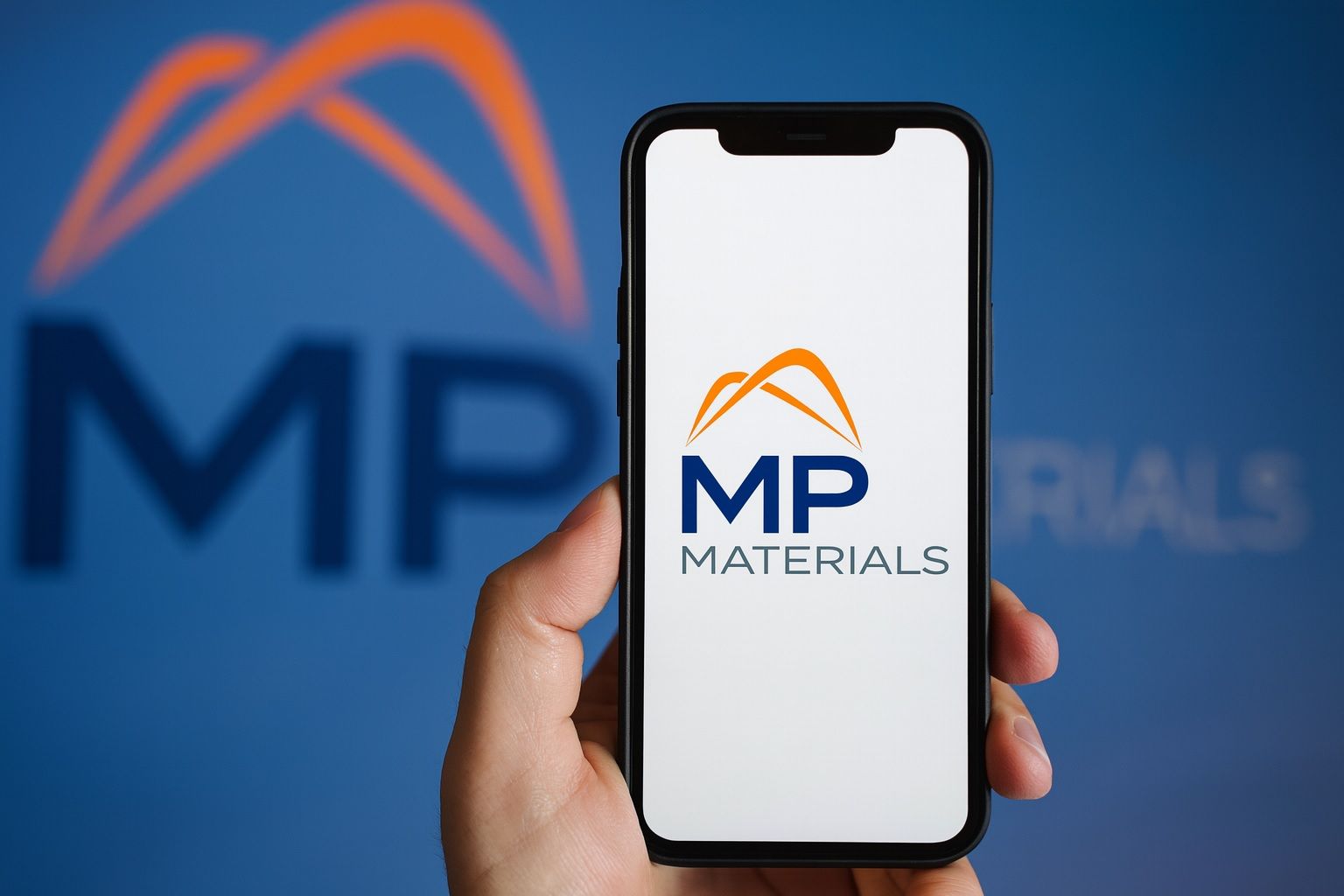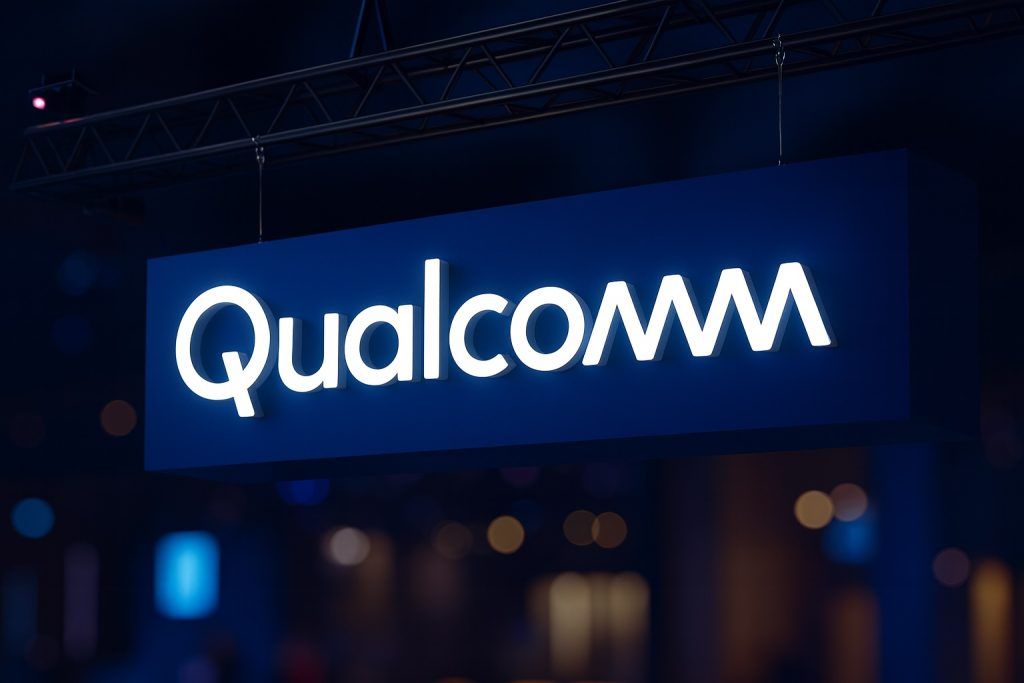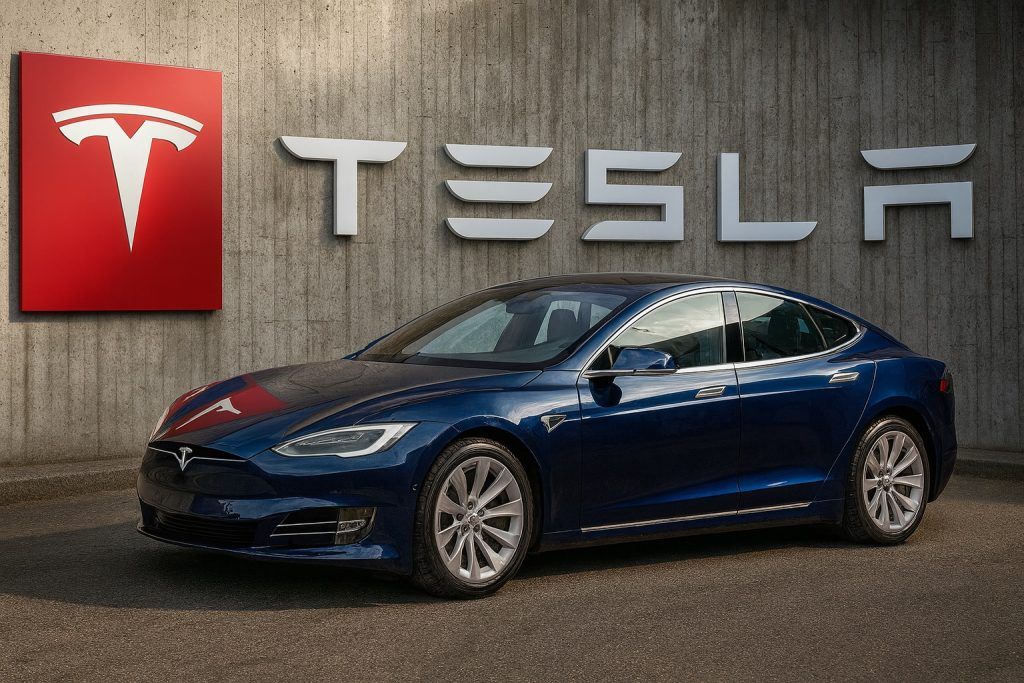- Surging Share Price: MP Materials (NYSE: MP) has been one of 2025’s top performers. The stock has soared ~350–380% year-to-date, climbing from about $15 in January to the mid-$70s recently [1]. It hit an all-time high near $82 in August and, as of Oct 10, 2025, trades around the high-$70s. Its 52-week range spans ~$15.5 to $82.5 [2], giving the company a market capitalization near $13–14 billion at current prices. This meteoric rise reflects heightened investor enthusiasm amid landmark deals and geopolitical tailwinds.
- U.S. Government Backing: In a historic public-private partnership this summer, the Pentagon invested $400 million into MP Materials for roughly a 15% equity stake. The Department of Defense (DoD) also extended a $150 million low-interest loan to upgrade MP’s refining capacity. Crucially, the DoD deal guarantees a floor price of $110/kg for MP’s key product (NdPr oxide used in magnets) for 10 years – nearly double the current Chinese market price [3]. It includes a 10-year offtake agreement for up to 100% of MP’s future magnet production, with a minimum ~$140 million per year EBITDA guarantee to MP. This unprecedented government support is aimed at bolstering a domestic rare earth supply chain for national security.
- Major Apple Alliance: In July, MP Materials inked a $500 million agreement with Apple (NASDAQ: AAPL) to supply U.S.-made rare earth magnets for Apple’s devices. Apple prepaid $200 million to help fund MP’s new magnet factory in Fort Worth, Texas (dubbed the “Project Independence” facility). The deal is a “first-of-its-kind” commitment by Apple to secure recycled and domestic rare earths, and it sent MP’s stock soaring ~20% on the announcement [4]. Apple will begin sourcing magnets from MP in 2027, and is also partnering with MP to recycle rare earths from old electronics at MP’s Mountain Pass site. This comes on top of MP’s existing magnet supply deal with General Motors for EV motors [5], positioning MP as a key supplier to both the tech and automotive sectors.
- Robust Growth vs. Ongoing Losses: MP Materials’ production volumes are climbing fast even as the company remains in an investment phase. In Q2 2025, production of neodymium-praseodymium (NdPr) oxide – critical for high-strength magnets – hit 597 metric tons, up 119% year-on-year. Total rare earth oxide output was 13,145 tons (+45% YoY). Quarterly revenue surged 84% YoY to $57.4 million, thanks to higher volumes and initial sales of processed magnet materials. Adjusted EBITDA was -$12.5M and the net loss came to $0.13 per share, marking MP’s 8th consecutive quarterly loss (though the loss was smaller than expected). Heavy spending on refining and magnet manufacturing has driven costs sharply higher (cost of sales was 94% of revenue in 2024, up from 37% a year prior). However, output is expected to keep rising – MP projects NdPr production to increase another ~10–20% sequentially in Q3 – and with the DoD price floor and Apple offtake kicking in, analysts foresee a potential turn to profitability by 2026.
- Analyst Sentiment: Wall Street is cautiously optimistic on MP. The stock carries a “Moderate Buy” consensus with 7 Buys and 4 Holds as of late September. The average 12-month price target is ~$65–$70, slightly below the current price – reflecting that MP’s rapid run-up has overshot some targets. Many analysts raised their targets dramatically after the DoD and Apple deals (e.g. DA Davidson hiked from $32 to $82; Canaccord Genuity to $77; Baird to $69; J.P. Morgan to $64). Jefferies also upgraded MP to Buy with an $80 target in August. Earnings forecasts indicate MP could swing from an estimated ~$0.34 loss per share in 2025 to +$0.80–0.90 EPS in 2026, and ~$1.20 in 2027, as higher-margin magnet sales ramp up. That implies a hefty forward P/E of 60×–90× on 2026 earnings, underscoring a rich valuation. Bulls argue MP’s strategic importance justifies a premium – “the contract with the DoD provides reliable cash flow, and the stock could do well as the U.S. supports domestic rare earth production,” notes one Motley Fool analyst. However, even supporters warn that the current valuation is demanding, and any execution hiccup or policy shift could spur volatility.
Spectacular Rally Fueled by Strategic Deals
MP Materials’ stock performance in 2025 has been nothing short of remarkable. Shares have exploded higher on the back of transformative deals and the prospect of a secure American rare-earth supply chain. The stock is up nearly 4-fold this year, recently trading around $75–$80 per share [6]. In late August, MP hit an all-time high near $82 before a brief pullback [7]. Even after cooling slightly, shares remain ~350% above where they started the year. Elevated trading volume accompanied this rally (e.g. 13+ million shares on one day in late September, ~42% above average), signaling intense investor interest.
Such a parabolic rise reflects mounting confidence that MP Materials has transitioned from a niche mining play into a strategic linchpin for tech and defense. In July, the U.S. government’s landmark investment (making DoD a major shareholder) instantly boosted sentiment. Just days later, Apple’s half-billion-dollar partnership added further fuel, sending MP stock up about 20% in one day [8]. By early fall, shares were regularly reacting to geopolitical news as well – spiking on headlines about Chinese export curbs or U.S. policy moves. Notably, on Oct 9–10, as China tightened rare earth export rules and U.S.-China tensions flared, MP’s stock jumped as much as 13% intraday even while broader markets sank [9]. This buck-the-trend rally underscores MP’s status as a “safe haven” strategic asset in the rare earths space – when geopolitical risk rises, investors pile into the one scaled American producer.
At current levels, valuations are steep. MP trades at >25× forward sales, vastly higher than the mining industry average (~1–2×) [10]. With no positive earnings yet, it has no meaningful P/E ratio, and even on 2026’s expected profits the stock would still be priced like a high-growth tech company [11]. The beta ~2.3 is also telling – this is a volatile stock prone to outsized swings [12]. In short, MP’s share price already bakes in big expectations. The bull case is that those expectations will be met (or exceeded) as recent deals translate into revenue and profits. The bear case is that the stock may have run too far, too fast, leaving little margin for error if execution or market conditions falter. We delve into those factors below.
Pentagon Partnership: A Game-Changer 📜
Arguably the single biggest catalyst for MP Materials’ rise was its blockbuster deal with the U.S. Department of Defense, announced in July. Under this public-private partnership, the DoD committed $400 million for a preferred equity investment – making it MP’s largest shareholder at ~15% ownership [13] [14]. “This is a game changer for the ex-China industry and a much-needed surge in magnet production capacity,” said Ryan Castilloux, managing director of Adamas Intelligence, about the deal [15]. The strategic rationale is clear: rare earth elements (like neodymium and praseodymium) are critical for missiles, fighter jets, drones, and other defense systems, yet the U.S. has relied almost entirely on Chinese supply. By taking a stake in MP, the Pentagon is effectively kick-starting a secure domestic source for these vital materials.
The agreement’s terms are striking. Over the next decade, the DoD will purchase up to 100% of MP’s production of certain rare earth products (notably NdPr magnets) for defense needs. It set a minimum price of $110/kg for NdPr oxide – nearly 2× the going market price in China – and will pay MP the difference if market prices stay below that floor [16]. This price support removes a huge uncertainty, given Chinese producers have historically depressed prices to undercut new entrants [17]. Additionally, the DoD is guaranteeing ~$140 million in annual EBITDA for MP starting in late 2025. Together, these provisions virtually ensure MP will have steady cash flow once its new production comes online, even if global rare earth prices remain weak. It’s essentially a government safety net for MP’s profitability – a rarity in the mining sector.
Importantly, the Pentagon funding will help MP scale up downstream. MP is using the capital to build a new rare earth magnet factory (dubbed the “10x Factory”) in the U.S. that will dramatically expand its magnet output (targeting 10,000 metric tons per year by 2028) [18] [19]. These magnets are the end product used in motors for electric vehicles (EVs), wind turbines, and advanced weapons. The goal is to create an end-to-end domestic supply chain: MP will mine and refine rare earth oxides at Mountain Pass, then convert them into finished magnets at its U.S. plants – with the DoD as an assured customer for a large portion of that output. MP’s CEO James Litinsky noted the partnership means “we’re meeting an important national security need while maintaining our free-market, public company approach” [20]. In practical terms, MP has agreed to stop sending any rare earth material to China for processing [21] (previously, MP’s concentrate was largely refined in China). All processing will now happen domestically or with allied nations, marking a turning point for U.S. rare earth independence.
For MP Materials, the Pentagon deal not only validates its business – it de-risks it. The company has a guaranteed buyer and floor pricing for its product, mitigating two key risks (lack of customers and volatile commodity prices) that junior miners typically face. Little wonder, then, that MP’s stock rocketed almost 50% in a day on the July announcement [22]. Washington’s backing has effectively elevated MP from a speculative mining play to a quasi-“mission critical” asset for the nation.
Apple Alliance and Corporate Ties 🍏🤝
Soon after the DoD’s vote of confidence, MP Materials scored another major partnership – this time with Apple Inc. Apple signed a $500 million, multi-year deal in July to procure rare earth magnets from MP [23]. The iPhone maker will begin using MP’s U.S.-made magnets in its devices starting in 2027, part of Apple’s initiative to localize its supply chain for critical materials. To jump-start the project, Apple provided a $200 million prepayment to MP. This effectively bankrolls the expansion of MP’s new Fort Worth, Texas magnet manufacturing facility, which MP has nicknamed “Project Independence.” Apple also agreed to collaborate on developing recycling processes for rare earths, so old iPhones and Macs can be mined for their magnet content and fed back into MP’s production loop.
The significance of this deal is hard to overstate. Apple is renowned for its exacting supply chain standards – its commitment signals that MP’s materials will meet the highest tech-industry specs. It also guarantees MP a high-profile commercial customer outside of defense. Along with a prior magnet supply arrangement with General Motors (for EV motor magnets), MP now has marquee customers in defense, consumer electronics, and automotive. This diversified customer base should give MP more stable demand and bargaining power. The Apple partnership in particular was described as a “major coup” that sent MP shares up ~20% on the news [24]. Investors see it as validation that MP can compete globally on quality and cost – Apple wouldn’t entrust a key component to them otherwise.
For Apple, the move was driven by geopolitics as much as economics. China controls about 70–90% of the world’s processed rare earth output [25] [26], and earlier this year Beijing curbed exports of certain rare earth products, jolting tech manufacturers. Apple is eager to insure against supply disruptions by cultivating an American source. The MP deal helps Apple secure a domestic pipeline of rare earth magnets (using recycled materials too, which aligns with its environmental goals). Apple’s operations chief Jeff Williams even highlighted that this will support a “first-of-its-kind” rare earth recycling facility in the U.S. [27]. In essence, Apple is paying upfront to help stand up a rare earth magnet supply chain on U.S. soil – something that simply did not exist at scale previously.
From MP’s perspective, these corporate alliances bring not just prestige but also capital and certainty. Apple’s $200M prepayment and the DoD’s $400M injection together bolstered MP’s balance sheet significantly, giving it funds to invest in processing plants and new production lines. The partnerships also come with multi-year purchase commitments (Apple’s contract reportedly spans 4+ years [28], and DoD’s a decade). This means once MP’s new facilities are online, much of their output is already spoken for under contract. CEO Litinsky has said these deals will drive “sustained growth in the emerging era of physical AI” [29] – pointing to a future where smart devices, EVs, and defense systems all depend on rare earth magnets, and MP plays a critical role in supplying them.
One caveat: the timelines. Apple’s magnet offtake doesn’t ramp up until 2027, aligning with its product roadmaps. The Pentagon offtake likewise depends on MP scaling production over the next 1–2 years. In the interim, MP must execute on building out its Texas magnet factory (targeting late 2025 commissioning) and expanding refining capacity at Mountain Pass (aiming for a 60,000 tonne per year run-rate by 2026). Investors appear willing to bet on these future payoffs – MP’s valuation reflects 2026–2028 earnings more so than today’s. But the company will need to hit these milestones to truly capitalize on its big-name partnerships.
Recent Developments (October 2025) 🔍
Geopolitical news in early October 2025 provided a fresh catalyst for MP Materials – and a stark reminder of why an independent rare earth supply chain is considered strategically vital. On October 9, Beijing unveiled sweeping new export controls on rare earth elements and related technology. China’s Ministry of Commerce announced that, effective Dec 1, any product containing more than trace amounts (0.1%) of Chinese-sourced rare earths will require an export license. The curbs also extend to the equipment and technology for rare earth mining, processing, and magnet manufacturing [30]. In effect, China is tightening its grip not just on raw rare earth exports, but on the entire know-how and machinery needed to produce high-end rare earth products. This move came ahead of a planned Trump–Xi meeting and was widely seen as Beijing upping the ante in the US–China trade war [31], using rare earths as a bargaining chip.
The market reaction was immediate. Rather than hurting MP (as one might expect when a major supplier restricts exports), the news sent MP’s stock sharply higher. Investors reasoned that China’s clampdown would force Western manufacturers to urgently seek non-Chinese sources for rare earths – benefiting the only game in town in the U.S., MP Materials. On Oct 9, MP shares spiked over 6% intraday on the announcement. The next day (Oct 10), as details of the export curbs percolated and broader markets sold off, MP surged even more – up about 13% by midday Friday [32]. Other U.S.-linked rare earth names (e.g. USA Rare Earth, an private developer, and Energy Fuels, which is entering rare earth processing) also saw double-digit gains. Clearly, Wall Street interpreted China’s actions as validation of MP’s strategic value. What threatens the rest of tech/industry (a supply squeeze) translates into a demand boom for MP’s output.
At the same time, Washington’s stance hardened further. U.S. President Donald Trump reacted to China’s export curbs with fiery rhetoric: on Oct 10 he threatened to escalate tariffs on Chinese goods and even floated cancelling his upcoming meeting with President Xi [33]. This signaled that trade tensions – which had appeared to be easing through mid-2025 – were back on high boil. Such tensions tend to benefit MP’s narrative. As The Motley Fool observed, “MP Materials has moved higher whenever geopolitical tensions rise and critical materials come to the forefront… If rare-earth imports are cut off, MP’s operations would only see more demand.” [34] [35]. That dynamic was on full display this month. It’s a reminder that MP’s stock can be highly sensitive to policy news: essentially moving inversely to U.S.-China relations.
In other recent news, MP Materials also formally closed the Pentagon deal in early October, finalizing the U.S. government’s equity stake. The DoD’s ~15% share purchase was completed, cementing the government as MP’s top shareholder (ahead of China’s Shenghe Resources, which owns ~8%) [36]. This wasn’t a surprise (it had been announced in July), but it underscores that the U.S. government now has real “skin in the game” with MP’s success. Additionally, the broader rare earth sector is abuzz with related developments – from new U.S. processing plant groundbreakings to allied countries (in Europe, Australia, etc.) investing in rare earth projects. All of this creates a supportive backdrop for MP. However, it also means competition is on the horizon (more on that in Industry Outlook below).
Financial Health: Growth and Investment Mode 📈
From a financial standpoint, MP Materials is a story of rapid growth paired with short-term red ink. The company is scaling up production at an aggressive pace, which is boosting top-line revenue, but heavy investments have kept earnings negative for now. Let’s unpack the latest numbers:
In Q2 2025, MP’s revenue was $57.4 million, up 84% year-over-year. This jump was driven by a combination of higher raw output and the initial sales of processed products (like rare-earth oxides and alloys from its new facilities). Notably, MP produced 597 tonnes of NdPr in Q2, a quarterly record and a 119% YoY increase. Total rare earth oxide (REO) production was over 13,000 tonnes for the quarter – a huge ramp that reflects the company’s “Phase II” project coming online (MP has been upgrading Mountain Pass to not just mine ore, but also separate it into refined oxides).
Despite this operational progress, profitability remained elusive. Q2 net income was a loss of $0.13 per share, and adjusted EBITDA was -$12.5 million. In fact, MP has now logged eight consecutive quarterly losses as it pours money into expansion. The culprit is soaring costs: in 2024, cost of sales was 94% of revenue, up from just 37% a year prior. Essentially, the new refining and pre-production costs are hitting the income statement before the corresponding revenue fully kicks in. The good news is MP’s balance sheet has been fortified by the recent Apple/DoD cash infusions, and the losses are narrowing relative to analyst expectations (Q2’s loss was smaller than feared).
The company’s cash flow has been under pressure – it reported negative operating cash flow of about $66M in the first half of 2025 – but with Apple’s $200M prepayment and the DoD’s $400M, MP should have sufficient liquidity to fund its major projects in the near term. It even launched a $500M public stock offering in mid-2025 (taking advantage of the soaring share price), ensuring it has a war chest to build out its facilities. MP carries only modest debt (partly a low-interest government loan) relative to its market value, so solvency isn’t a concern at present. The primary financial question is how quickly MP can flip to positive earnings and cash flow as its new revenue streams come online.
On that front, analysts are optimistic about 2026–27. The consensus is that MP will turn profitable sometime in 2026, with ~$0.80-$0.90 EPS in 2026 and accelerating into 2027. Wall Street projects revenue to roughly double from 2024 to 2026 as MP sells not just raw concentrate but high-value oxides and magnets (which command far higher prices). Gross margins are expected to improve dramatically once the costly ramp-up phase ends and the DoD price floor kicks in by Q4 2025. Indeed, starting in late 2025, MP will effectively have a baseline EBITDA of $140M/year guaranteed from the government contract – providing a level of earnings stability unheard of in the mining world. This should help cover fixed costs and potentially push MP into the black even if market prices for rare earths stay soft.
However, current valuation multiples already reflect a lot of this future success. At ~$75/share, MP trades at astronomical multiples of its present earnings (since earnings are negative) and a very high forward P/E based on 2026 estimates (60×+). Its price-to-sales ratio is over 25× forward, compared to low single-digits for most mining or materials firms [37]. In other words, investors are valuing MP more like a Silicon Valley growth stock than a commodity producer. This makes sense only if one believes MP will achieve a dominant, high-margin position in the rare earth supply chain with sustained growth for years to come. The company’s financial health today is fine – it’s well-funded and growing – but the stock’s pricing implies huge growth and margin expansion ahead. Any shortfall in execution (delays in the new factory, cost overruns, etc.) or a shift in the favorable policy environment could cause a significant reassessment of those expectations.
Analyst Forecasts & Upgrades 🔎
Following MP’s string of headline-making deals, analysts have largely warmed up to the stock, though valuation concerns temper their enthusiasm. As mentioned, MP has a Moderate Buy consensus. Drilling down: 7 of 11 analysts call it a Buy, 4 say Hold, and none outright say Sell. But intriguingly, the average price target (~$68) sits below the current trading price. This reflects that MP’s share price sprinted far ahead of where analysts had pegged its value even a few months ago. In fact, after the Pentagon and Apple announcements, we saw a wave of target upgrades: For example, DA Davidson raised their target from $32 to $82 (maintaining a Buy rating), Canaccord Genuity jumped to $77 (Buy), Baird to $69 (Outperform), and J.P. Morgan to $64 (Neutral). Even Jefferies, which had been on the sidelines, upgraded MP to a Buy on August 1 with an $80 target. Essentially, Wall Street dramatically recalibrated its models to account for MP’s new guaranteed revenue streams and growth trajectory.
Despite those hikes, MP promptly traded above many of these targets. The Street’s high target now is around $80 (implying only a bit of upside), while the lowest is about $33 (a Jefferies scenario from before their upgrade). This spread shows the uncertainty in how to value MP: it’s either a game-changing growth story (hence $80+ targets) or an overextended stock due for a pullback (hence the lone $30s estimate).
On the earnings front, consensus models predict 2025 will be MP’s last unprofitable year, with a sharp inflection in 2026. As noted, the average EPS forecast for 2026 is in the ~$0.80 range (some are as high as ~$1.00), and ~$1.20+ for 2027. Analysts at Zacks Investment Research recently highlighted that earnings estimates have been revised upward post-DoD deal (they now expect a swing from a ~$0.34 loss in 2025 to +$0.91 in 2026). Zacks accordingly gave MP a Rank #2 “Buy” rating, signaling positive momentum in its earnings outlook.
Those bullish on MP argue that traditional valuation metrics aren’t fully capturing its strategic value. To quote a Motley Fool analysis: “the contract with the DoD provides reliable cash flow, and the stock could do well as the U.S. supports domestic rare earth production”. In other words, MP should be viewed more like an infrastructure-like asset with guaranteed demand, or even as a quasi-extension of industrial policy – merits that few standard mining companies have. Additionally, if MP truly becomes the Western world’s primary source of critical magnet materials, the potential market is enormous (demand from EVs, wind, defense, electronics, etc., is forecast to grow substantially through the decade). Some analysts have also pointed out the scarcity premium: MP is one of very few investable rare earth plays outside China, so it may continue to command outsized investor interest relative to peers.
Still, nearly every analyst commentary includes a valuation caution. As Baird put it in a note, MP’s execution must be “nearly flawless” to justify the current price. If the ramp-up takes longer, or rare earth prices don’t firm up as expected (beyond the DoD-covered portion), the stock could underperform. There’s also the risk that policy support could ebb under a different political climate (though for now it’s strong). Given these unknowns, some analysts recommend moderation. For example, one analysis suggested waiting to see MP’s new magnet factory actually operational (expected by 2026) before betting heavily – effectively, “prove that the grand plans can be delivered” first. The overarching sentiment: great company, but fully valued. Investors should keep an eye on upcoming earnings (Q3 2025 results on Oct 29) for updates on project timelines and any hints of profitability turning the corner.
Rare Earths Industry Context & Geopolitics 🌍
MP Materials does not exist in a vacuum – its fortunes are tightly interwoven with the global rare earths market and U.S.-China geopolitics. Rare earth elements (like neodymium, praseodymium, dysprosium, etc.) are often called the “vitamins” of modern technology. They are small in volume but essential in function, enabling everything from the tiny vibration motor in an iPhone to the giant generators in a wind turbine. The most valuable product in this sector is NdFeB magnets (neodymium-iron-boron magnets), which pack incredible magnetic strength and are critical for EV motors, drones, missiles, and many high-tech devices. MP’s mine in Mountain Pass, California provides the raw materials (ore) for these magnets, primarily Nd and Pr. However, mining is just one part – the processing and magnet manufacturing steps are complex and have long been dominated by China.
For the past few decades, China has held a near-monopoly on rare earths. It accounts for about 70% of global rare earth mine production and around 90% of processed rare earth oxides [38] [39]. This dominance isn’t due to geology (countries like the U.S., Australia, and others have rare earth deposits) but rather China’s strategic development of the entire supply chain and its ability to undercut prices. In 2010, China famously leveraged this position by restricting rare earth exports during a spat with Japan, sending rare earth prices soaring and sparking global concern. Fast forward to 2023–2025, and rare earths have once again become a geopolitical pawn. Facing trade pressures from the U.S., Beijing has repeatedly wielded export controls on these materials as a form of retaliation or negotiation tactic [40]. In 2025 alone, China announced export restrictions in April (targeting specific elements like Dy, Tb, etc.), then expanded the list in July and October to include more elements and even related technologies. These moves underscore a simple reality: whoever controls rare earth supply can exert pressure on high-tech industries globally.
The U.S., for its part, has classified rare earths as critical minerals and is scrambling to reduce reliance on China. This has bipartisan support, transcending administrations. In March 2025, President Trump invoked the Defense Production Act to boost domestic mining and processing of critical minerals [41]. And as we’ve detailed, the DoD directly invested in MP – a clear statement that rare earth independence is a national security priority. Additionally, the U.S. and allied countries are funding other projects: for example, Australia’s Lynas Corp (one of the only other major rare earth producers outside China) received funding to build a separation facility in Texas; a joint U.S.-EU initiative is exploring supply chain cooperation; and startups like USA Rare Earth are trying to develop new mines (e.g., the Round Top project in Texas).
Amid this landscape, MP Materials currently enjoys a first-mover advantage among Western rare earth ventures. It operates the Western Hemisphere’s only active rare earth mine of scale, and crucially, is the farthest along in developing vertically integrated capabilities (mine-to-magnet). Many peers remain years away from production or lack downstream processing. This positions MP as the go-to supplier as companies like Apple and defense contractors seek non-Chinese sources. However, MP’s near-monopoly on U.S. production could erode over time as competitors come online. For instance, Energy Fuels is experimenting with processing rare earths at its uranium mills; NioCorp (Elk Creek project) aims to produce rare earths in Nebraska; and European projects (in Estonia, Norway, etc.) are being funded to challenge China’s hold. MP will need to maintain its technological and operational edge to fend off competition in the back half of the decade.
Another challenge is that China is not standing still. Beijing can deploy multiple strategies to blunt new rivals. One is price manipulation – China can flood the market or undercut prices (since its state-backed firms can sustain losses) to make projects elsewhere uneconomical. Indeed, rare earth prices have been relatively low in recent years precisely because Chinese supply was abundant, which deterred investment in places like the U.S. (hence the need for a price floor like the DoD provided) [42]. China could also leverage its stranglehold on heavy rare earths. Not all rare earths are the same – “light” REEs like Nd, Pr are abundant at Mountain Pass, but “heavy” REEs like dysprosium (needed for heat-resistant magnets in EV motors) are still almost exclusively processed in China. MP’s current operations are focused on light REEs; however, it plans to add heavy rare earth separation capabilities at Mountain Pass (funded in part by the recent DoD loan) [43]. Successfully doing so would be another huge step, as it would allow the U.S. to produce a full spectrum of rare earth materials domestically. Until then, some heavy REE needs (for certain military tech or specialized magnets) remain a vulnerability.
Geopolitically, rare earths have become a key front in the broader U.S.-China strategic competition – alongside semiconductors (where the U.S. is curbing chip exports to China, and China is retaliating with mineral curbs) [44]. The tit-for-tat dynamic was neatly summarized by Bloomberg: China has repeatedly used rare earth export controls as leverage, while the U.S. has used advanced semiconductors as its leverage [45]. Each side is targeting where the other is dependent. The latest Chinese action even targets the tools and equipment needed to make magnets and process rare earths [46], a sign of how far China is willing to go to maintain its dominance. This essentially means countries trying to build their own rare earth facilities might struggle to source specialized machinery if it originates from China. It’s a reminder that breaking free of a decades-long dependency is complex; it’s not just about having a mine, but replicating an entire ecosystem of refining technology, skilled workforce, and end-use manufacturing.
For investors in MP and the rare earth sector, this backdrop presents both an opportunity and a risk. The opportunity is clear: if U.S.-China decoupling in critical minerals continues, companies like MP become linchpins of new supply chains and stand to see sustained demand and price support. Governments might even enact mandates or incentives (e.g., require defense contractors to source domestically, or provide tax breaks for using U.S.-made critical minerals). The risk, however, is that the fragile equilibrium could shift – for example, if trade tensions unexpectedly ease or China suddenly increases exports (to regain goodwill or outcompete nascent rivals), rare earth prices could drop or the urgency to buy from MP could lessen. Additionally, any major technological breakthrough (such as motors that use no rare earth magnets, an area of active research) could disrupt long-term demand – though such changes, if they come, are likely many years out and incremental.
In summary, MP Materials operates in a strategic industry at the nexus of geopolitics and technology. Its rise has been accelerated by trade war dynamics that made everyone from the Pentagon to Apple realize that a non-Chinese rare earth source is not just nice-to-have, but imperative. This industry context provides a powerful tailwind for MP’s business model, but it also means the company’s outlook is tied to political decisions and global economic shifts that can be hard to predict.
Outlook and Investment Risks ⚖️
Looking ahead, MP Materials faces a pivotal 6–12 months that will test whether it can start turning its hype into tangible financial rewards. Several key catalysts loom on the horizon:
- New Magnet Factory Launch: By late 2025, MP aims to commission its Fort Worth magnet plant and begin shipments in early 2026. Successful startup of this facility (and meeting quality/output targets) will be critical, as it unlocks the revenue from Apple and defense contracts. Any delays or production snags here could rattle investors who are banking on the timeline.
- Scaling Up Refining (Phase II): At Mountain Pass, MP is ramping its separation facilities toward full capacity. The company is targeting a run-rate of 60,000 tonnes/year of REO production by 2026 (which would be a 2×+ increase from current levels). Hitting that aggressive target a year ahead of schedule would impress the market, while falling short might raise questions. Additionally, initiating the planned heavy rare earth separation project (funded by the DoD loan) will be watched closely – investors know that cracking the heavy REE puzzle would further widen MP’s moat.
- Rare Earth Price Movements: Although MP now has some price insulation (the DoD floor), the general market price of rare earths will still influence sentiment. If China’s export curbs lead to global shortages, prices for NdPr oxide and magnets could rise, providing an upside surprise to MP’s un-contracted sales. Conversely, if China or others flood the market or demand falters (for instance, if EV sales were to slow macro-economically), it could temper enthusiasm. Notably, starting in Q4 2025, MP’s earnings will get a boost from the Pentagon’s EBITDA guarantee (~$140M/yr), making results more predictable. But that also means investors might expect cleaner profitability by 2026 – the safety net will be in place. Failure to achieve positive earnings once the guarantees kick in would be a red flag.
- New Offtake Deals: As MP’s capacity grows, the company will likely seek additional customers beyond Apple, GM, and the DoD. Management has hinted at targeting other EV, wind turbine, or electronics firms for magnet sales. A new commercial offtake agreement (say with another automaker or an industrial giant) could be a catalyst that validates demand for MP’s expanded output. It would also diversify its revenue streams. On the flip side, if MP remains overly dependent on just a few buyers, that concentration could be viewed as a risk if any one partnership wavers.
In terms of investment risks, several stand out:
- Execution Risk: MP is simultaneously scaling a complex chemical processing operation and building a manufacturing business (magnet production) from scratch. These are ambitious engineering and operational challenges. Delays, cost overruns, or quality control issues could occur. Any sign that the “Phase II” ramp or magnet output is lagging plan might prompt a stock pullback, given how much optimism is already priced in.
- Policy/Geopolitical Risk: MP’s story is closely tied to U.S. government support and trade conflict with China. While bipartisan support for rare earth resilience is strong, it’s possible future political shifts could alter funding or priorities. For example, if relations with China unexpectedly improve, pressure to secure non-Chinese supply chains might ease (dimming some of MP’s allure). Conversely, if a trade war escalates too far, broader market turmoil could impact high-valuation stocks like MP even if the company is fundamentally advantaged. Investors are essentially betting on continued geopolitical impetus for MP’s business – a reasonable bet, but not a guaranteed one.
- Commodity Price & Market Risk: Rare earth prices can be volatile, and historically have been manipulated. If China decides to undercut prices (e.g., drops NdPr oxide to $30/kg to squeeze newcomers), MP would rely on the U.S. price floor to stay profitable – essentially shifting the burden to taxpayers. That scenario could test political support. Also, global demand for rare earth magnets is tied to cyclical industries (autos, electronics, energy). A downturn in EV sales or clean energy investment, for instance, could slow magnet demand growth. MP’s current valuation doesn’t leave much room for macro hiccups; it assumes a pretty rosy growth curve.
- Valuation & Sentiment Risk: As emphasized, MP’s stock is priced for hyper-growth. Any disappointment – even a minor earnings miss or a guidance that is merely “in line” – could trigger an outsized stock reaction. High-multiple stocks often correct harshly on any hint that reality might not live up to the story. Moreover, if interest rates continue rising, the market’s tolerance for richly valued, earnings-in-the-future companies may wane, which could pressure MP’s valuation. Already, there are signs some investors are cautious; for example, insider and early-investor lockups expiring led to some profit-taking, and there was a secondary share offering. New investors should be prepared for continued volatility (the stock’s >2 beta backs that up [47]).
- Competition and Innovation: While MP is ahead now, a few years out it may face competition from other rare earth initiatives in the West. If one of those were to achieve a breakthrough (say, a more efficient processing method or a larger-scale operation), MP’s first-mover advantage could narrow. Additionally, alternative technologies (like rare-earth-free motors or improved recycling that reduces primary demand) present long-term risks. Major companies (e.g., some automakers) are researching ways to reduce or eliminate rare earth magnet usage, though such shifts, if viable, are likely many years away and gradual. Still, it’s a space to watch.
Bottom Line: MP Materials has rapidly transformed from a speculative mining stock into a strategic pillar of U.S. industry in the span of a year. It enjoys tailwinds from Washington and Cupertino alike, a virtually captive domestic market, and a rising tide of demand for the “vitamins” of the tech and green revolutions. The company’s execution so far – ramping production and securing big partners – deserves credit. Looking forward, if MP can smoothly execute its expansion and start delivering magnets and profits, it could firmly establish itself as the Western champion of rare earths, with a growth trajectory to match. However, given the lofty stock price, investors should stay level-headed about risks. As one market commentator put it, you shouldn’t “rely on a single company to build wealth” – the prudent approach is to make MP a part of a diversified portfolio, sizing the position according to one’s risk tolerance. In the end, MP Materials offers a rare chance (pun intended) to invest in the backbone of future tech and defense, but it comes with the twists and turns inherent to both emerging industries and geopolitics. Keep your seatbelt fastened – this ride is likely to stay dynamic.
Sources: TS2 Tech, Reuters, Bloomberg, Motley Fool/Nasdaq, NAI 500, company releases. Relevant citations included throughout. [48] [49] [50]
References
1. ts2.tech, 2. ts2.tech, 3. www.channelnewsasia.com, 4. www.reuters.com, 5. ts2.tech, 6. ts2.tech, 7. ts2.tech, 8. www.reuters.com, 9. www.nasdaq.com, 10. ts2.tech, 11. ts2.tech, 12. ts2.tech, 13. www.channelnewsasia.com, 14. www.channelnewsasia.com, 15. www.channelnewsasia.com, 16. www.channelnewsasia.com, 17. www.channelnewsasia.com, 18. www.channelnewsasia.com, 19. www.channelnewsasia.com, 20. www.channelnewsasia.com, 21. www.channelnewsasia.com, 22. www.channelnewsasia.com, 23. www.reuters.com, 24. www.reuters.com, 25. www.channelnewsasia.com, 26. www.nasdaq.com, 27. www.apple.com, 28. www.instituteforenergyresearch.org, 29. ts2.tech, 30. www.bloomberg.com, 31. www.bloomberg.com, 32. www.nasdaq.com, 33. www.nasdaq.com, 34. www.nasdaq.com, 35. www.nasdaq.com, 36. www.channelnewsasia.com, 37. ts2.tech, 38. www.channelnewsasia.com, 39. www.nasdaq.com, 40. www.bloomberg.com, 41. www.channelnewsasia.com, 42. www.channelnewsasia.com, 43. www.channelnewsasia.com, 44. www.bloomberg.com, 45. www.bloomberg.com, 46. www.bloomberg.com, 47. ts2.tech, 48. ts2.tech, 49. www.channelnewsasia.com, 50. www.nasdaq.com










